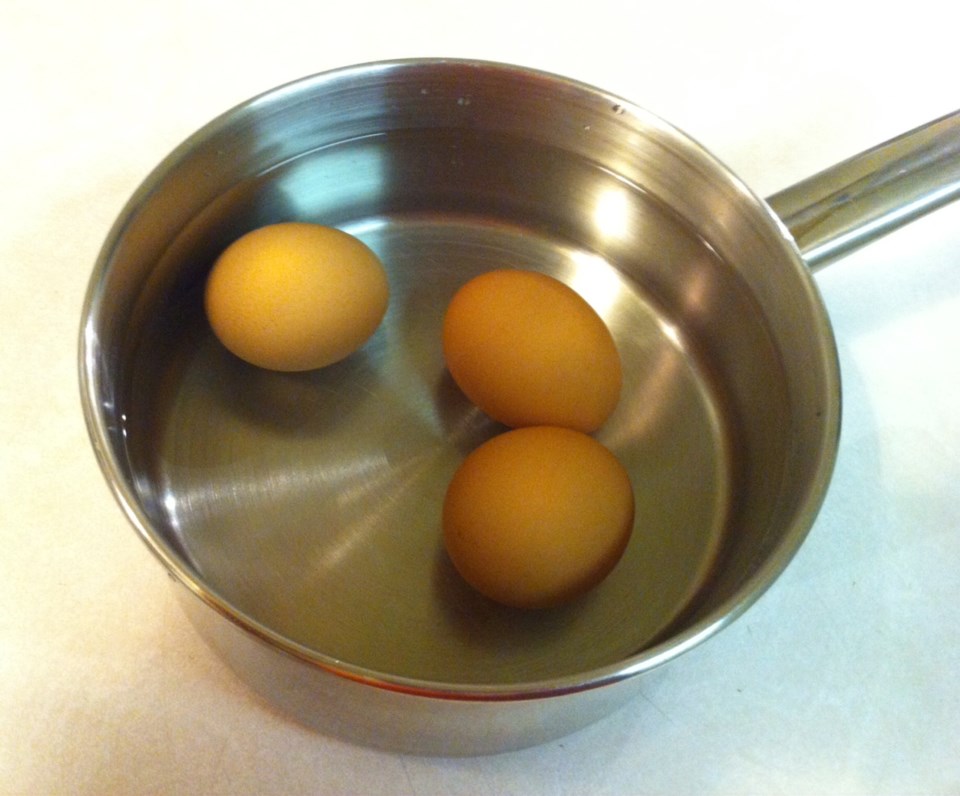Some generally agreed upon concepts discovered in a survey of the egg-peeling literature (mostly found on food websites).
To make the peeling of boiled eggs easier:
Use older eggs; the shell sticks more tenaciously to the cooked whites of fresher eggs.
Boil the eggs longer. There’s a tradeoff here. If you boil them too long, you’ll have rubbery eggs with an unsightly grey ring around the yolk and an unpleasant smell.
Cool them in ice water, the longer the better.
I used to be pretty good at peeling boiled eggs. In fact, I was a semi-professional, assigned the task in a restaurant kitchen. But in recent years, my egg-peeling prowess has been pitiful. As in full of pits. (Sorry.)
Judging from the many, many Internet posts about egg peeling, a lot of people have trouble with this.
Two things that you see recommended but definitely don’t work, according to people who have experimented extensively, are adding salt to the boil water or adding baking soda to the boil water. The baking soda, apart from not working, also triggers a sulphur smell.
Other suggestions that are backed by less consensus than the three listed at the top:
Peel a reluctant releaser under running water or in a bowl of water. I’ve tried this. It didn't seem to help, but the shell bits get washed away, which might be the prime intent of this suggestion.
Leave in the fridge overnight after boiling. I didn't notice an improvement in peeling ease.
After cooling in ice water, tap the egg all over on a countertop or using a spoon, then gently roll on a counter or in your hands to loosen the shell from the white. This might work; logic says it should. I’ve had so-so success. I need to practice more.
Before putting into ice water to cool, crack the shells slightly by rolling eggs around in a dry pan. This mostly worked on two of three eggs.
With an egg that has a wobbly white and a runny yolk, crack it in the middle as you would a raw egg and break open into a bowl or onto a plate. This works. But the eater needs to be a person who enjoys soft-cooked eggs. Also, it’s short of cheating, because you’re not peeling the egg.
With a soft-cooked egg again — crack the wide end of the egg in the area of the air pocket, remove enough shell to allow you to slide in a small spoon. Run that spoon underneath the shell until the egg comes free. This works if you practice. I’ve been semi-successful and I can see that I could become a whiz if I devoted a few more hours to it.
In a 5,000-word exploration of egg peeling that sacrificed dozens of eggs, J. Kenji López-Alt at seriouseats.com concluded that the way eggs are cooked matters a lot. His recommendation: use older eggs, take them straight from the fridge to water that’s already boiling, lower the temperature to barely simmering. You could also steam the eggs. When cooked for the desired time, immediately place into ice water and leave for at least 15 minutes. Crack all over and place under running water while peeling.
My still in-progress conclusions after several weeks of egg peeling experiments: you have a higher probability of an almost-pit-free peel if you cook the egg into the 10-minute-plus range. But I don’t like eggs cooked that much. I think the eggs from my brief restaurant career were long-cooked eggs, making them easy to peel.
For the seven-or-so-minute eggs that I prefer, the peel-with-a-spoon technique might be the winner, if I practice more. Also, cooking in simmering water from the start shows great promise.
Here’s a video demonstration of the spoon technique at chatelaine.com. For cooking, they favour heating water to near boiling, then putting eggs in; the popular alternative is to put eggs into a pot of cold water, cover with lid, heat to boiling, remove from heat with cover on and let stand.
At latimes.com: Peel away the complications of the perfect hard-boiled egg
Martha Stewart demonstrates egg peeling. Towards the end of the video, I think I see a gouge developing. (There’s a commercial first.)
A discussion about using baking soda when boiling eggs at thekitchn.com
Advice from the Egg Farmers of Canada. They suggest some alarmingly long cooking times.
Update, Feb. 12, 2015: Several readers have chimed in: the baking soda method works, poke a pinhole in one end of the egg. Also, use a pressure cooker; high pressure cooking is apparently how hard-cooked eggs are made in high volume at food plants. Here's another article on pressure-cooking eggs.
I was also sent a link to a video showing someone putting a hard-cooked egg into a glass of water, holding a hand over the opening and shaking vigorously. The shell appears to come off in almost one piece. I tried this with an eight-minute egg and it didn't work. The shell cracked but didn't come off. I'm guessing this might work if the egg involved is cooked a lot longer.
- - -
- - -
Most-popular posts:
Via rolls out rooms with double bed on Vancouver-Toronto train
Accidentally at the forefront of fashion with L.L. Bean boots
Favourite restaurant meals of 2014
10 gadgets that were worth buying
To stay cool, leave house windows closed or open?
A guide to public toilets in downtown Victoria
How to block unwanted text messages
Why B.C. Hydro bills sting more on Vancouver Island
Why newer dishwashers run for an alarmingly long time
Most credit cards charge 2.5% for currency conversion; a few charge 0%
Why paying $720 for a phone can be a better deal than a 2-year contract
Tips to make applying for a passport a little easier
How to pronounce Ucluelet, Tsawwassen, and that outdoor gear place
How to travel between Victoria and Vancouver on public transit
- - -



